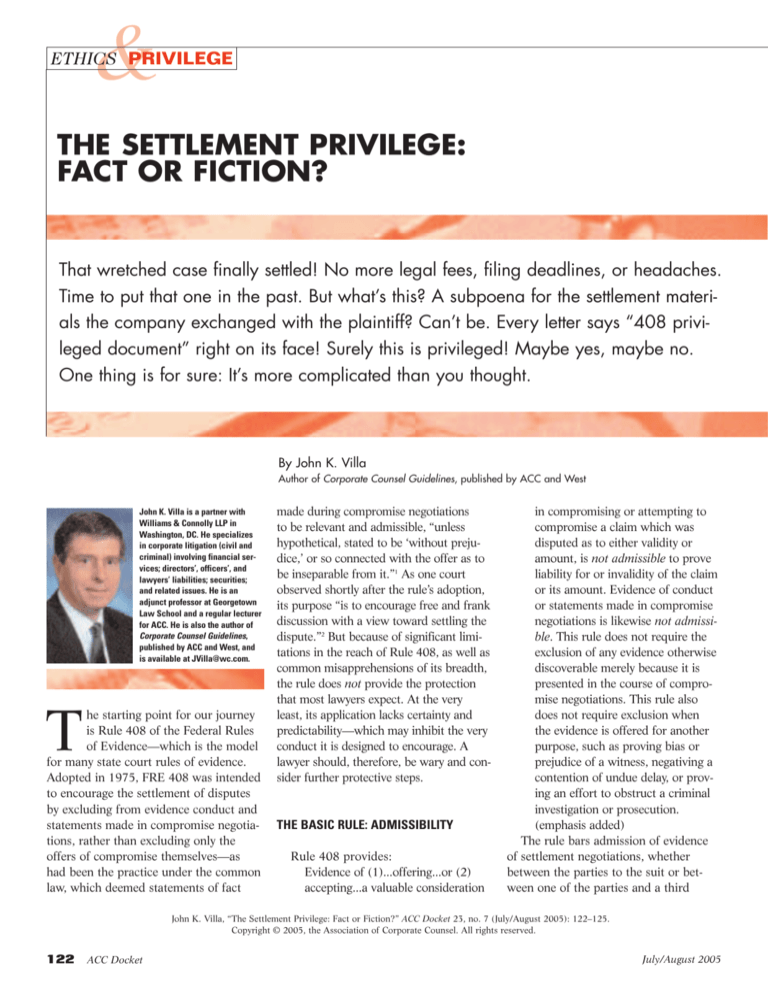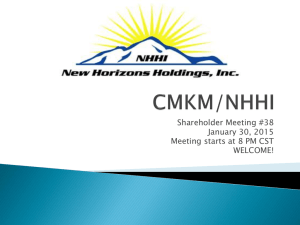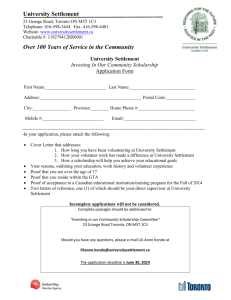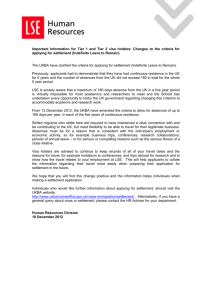
&
ETHICS PRIVILEGE
THE SETTLEMENT PRIVILEGE:
FACT OR FICTION?
That wretched case finally settled! No more legal fees, filing deadlines, or headaches.
Time to put that one in the past. But what’s this? A subpoena for the settlement materials the company exchanged with the plaintiff? Can’t be. Every letter says “408 privileged document” right on its face! Surely this is privileged! Maybe yes, maybe no.
One thing is for sure: It’s more complicated than you thought.
By John K. Villa
Author of Corporate Counsel Guidelines, published by ACC and West
John K. Villa is a partner with
Williams & Connolly LLP in
Washington, DC. He specializes
in corporate litigation (civil and
criminal) involving financial services; directors’, officers’, and
lawyers’ liabilities; securities;
and related issues. He is an
adjunct professor at Georgetown
Law School and a regular lecturer
for ACC. He is also the author of
Corporate Counsel Guidelines,
published by ACC and West, and
is available at JVilla@wc.com.
T
he starting point for our journey
is Rule 408 of the Federal Rules
of Evidence—which is the model
for many state court rules of evidence.
Adopted in 1975, FRE 408 was intended
to encourage the settlement of disputes
by excluding from evidence conduct and
statements made in compromise negotiations, rather than excluding only the
offers of compromise themselves—as
had been the practice under the common
law, which deemed statements of fact
made during compromise negotiations
to be relevant and admissible, “unless
hypothetical, stated to be ‘without prejudice,’ or so connected with the offer as to
be inseparable from it.”1 As one court
observed shortly after the rule’s adoption,
its purpose “is to encourage free and frank
discussion with a view toward settling the
dispute.”2 But because of significant limitations in the reach of Rule 408, as well as
common misapprehensions of its breadth,
the rule does not provide the protection
that most lawyers expect. At the very
least, its application lacks certainty and
predictability—which may inhibit the very
conduct it is designed to encourage. A
lawyer should, therefore, be wary and consider further protective steps.
THE BASIC RULE: ADMISSIBILITY
Rule 408 provides:
Evidence of (1)...offering...or (2)
accepting...a valuable consideration
in compromising or attempting to
compromise a claim which was
disputed as to either validity or
amount, is not admissible to prove
liability for or invalidity of the claim
or its amount. Evidence of conduct
or statements made in compromise
negotiations is likewise not admissible. This rule does not require the
exclusion of any evidence otherwise
discoverable merely because it is
presented in the course of compromise negotiations. This rule also
does not require exclusion when
the evidence is offered for another
purpose, such as proving bias or
prejudice of a witness, negativing a
contention of undue delay, or proving an effort to obstruct a criminal
investigation or prosecution.
(emphasis added)
The rule bars admission of evidence
of settlement negotiations, whether
between the parties to the suit or between one of the parties and a third
John K. Villa, “The Settlement Privilege: Fact or Fiction?” ACC Docket 23, no. 7 (July/August 2005): 122–125.
Copyright © 2005, the Association of Corporate Counsel. All rights reserved.
122
ACC Docket
July/August 2005
party.3 In some jurisdictions the rule may
apply to criminal cases.4 Note that the
rule literally applies only to the admissibility of evidence—though, as we will
see, some courts have interpreted the
rule more broadly.
The two prerequisites for Rule 408
are the existence of both a disputed
claim and compromise negotiations.
Unfortunately, there is no bright line as
to when a claim is “disputed,” or at
what point discussions become “compromise negotiations.” For example,
does a dispute exist when contracting
parties meet to state conflicting positions that, depending on the outcome
of their discussion, could result in litigation, or are these preliminary discussions mere business communications
rather than negotiations covered by
Rule 408?5 To answer this question,
some courts focus on the intent of the
parties, while other courts focus on the
objective characteristics of the discussions.6 The general rule is, however,
that a lawsuit is not necessary for a
dispute to exist under Rule 408.7 It is
sufficient if the parties are contemplating the possibility of litigation when
they are discussing the matter.8
Where these prerequisites have been
met, Rule 408 makes inadmissible
offers to settle as well as conduct and
statements occurring in the negotiations. An important but overlooked
aspect of the 408 protection is that it
extends not only to the parties’ communications, but also to material prepared
by or for the parties in their effort to
reach a settlement. This has included
internal memoranda, reports, expert
opinions, depositions, and a wide range
of other materials.9
One limitation on the scope of Rule
408 is that by its terms it excludes settlement evidence only when offered “to
prove liability for or invalidity of the
claim or its amount,” and not when
“offered for another purpose, such as
proving bias or prejudice of a witness,
negativing a contention of undue delay,
or proving an effort to obstruct a crimi-
Do Not Miss John K. Villa’s
Corporate Counsel Guidelines
published by ACC and West
In this post-Enron environment, you
need the best ethics guidance that
you can get. Here it is. Corporate
Counsel Guidelines is a two-volume
treatise written expressly for inhouse counsel. This treatise tackles
the most common issues facing corporate counsel, even those issues that
have no guiding precedent or ethics
opinions. Cost: $220, and ACC members
receive a 30% discount. To order, contact
West at 800.344.5009 or at www.westgroup.com.
July/August 2005
nal investigation or prosecution.”
But even if one of these exceptions
is satisfied, settlement evidence is still
subject to Rule 402’s requirement of
relevance and Rule 403’s requirement
that probative value outweigh the danger of unfair prejudice. As one court has
observed: “[t]he risks of prejudice and
confusion entailed in receiving settlement evidence are such that often Rule
403 and the underlying policy of Rule
408 [to encourage settlement] require
exclusion even when a permissible purpose can be discerned.”10 To further
reduce the risk of a finding of admissibility, counsel may want to rely on the
traditional common law standards—
qualifying statements in settlement
materials through the use of hypotheticals or “without prejudice” notations.
EXTENDING THE RULE:
DISCOVERABILITY?
OK so far, but here’s the question:
assuming that Rule 408 excludes certain settlement materials from evidence,
are such materials also protected from
discovery? Surprisingly, some courts
hold that the answer is “yes.” Although
Rule 408 expressly addresses only the
admissibility of settlement offers and
statements made in compromise negotiations, some courts have found that
the public policy underlying the rule—
promoting the private settlement of disputes—supports the extension of Rule
408 protections to the discovery stage
of litigation.11 As one court explained:
There is a strong public interest in
encouraging settlements and in promoting the efficient resolution of
conflicts. This strong public interest
outweighs any general public interest
in providing litigants broad discovery
of facts to support their claims and
defenses....The balance of the equities weighs in favor of protecting the
ACC Docket
123
&
ETHICS PRIVILEGE
terms of the Agreement and the surrounding circumstances.12
In fact, a few courts have adopted a
curious rationale for denying the discovery of settlement information—the
recognition that settlement discussions
do not necessarily involve wholly truthful assertions!
Settlement negotiations are typically
punctuated with numerous instances
of puffing and posturing[.]...What is
stated as fact on the record could
very well not be the sort of evidence
which the parties would otherwise
actually contend to be wholly true.
That is, the parties may assume disputed facts to be true for the unique
purposes of settlement negotiations.
The discovery of these sort of
“facts” would be highly misleading
if allowed to be used for purposes
other than settlement.13
Most courts, however, reject an
absolute principle that Rule 408 insulates settlement evidence from discovery under Rule 26(b) of the Federal
Rules of Civil Procedure, which
authorizes discovery of “any matter,
not privileged, that is relevant to the
claim or defense of any party[.]”14
Some courts have compromised by
applying a heightened standard to the
party seeking discovery, citing “the
strong public policy of favoring settlements and the congressional intent to
further that policy by insulating the
bargaining table from unnecessary
intrusions[.]” These courts have permitted discovery upon a “particularized showing of a likelihood that
admissible evidence will be generated”
by discovery.15 But the result of such
a compromise is a disregard of Rule
26(b), which authorizes the discovery
of relevant, inadmissible information
if “reasonably calculated to lead to
the discovery of admissible evidence,”
and does not require any such particularized showing.16
124
ACC Docket
OTHER PROTECTIONS FROM DISCOVERY
In view of the limited reach of Rule
408 and its uneven application, are
there other methods—court rules,
statutes, agreements—that you can use
to protect settlement documents and
other exchanges of information during
the settlement process? One possibility
is an express confidentiality agreement
between the negotiating parties. Such
agreements can effectively insulate settlement materials from discovery—but
they are of limited usefulness, as they
do not bind third parties.17
IN THE FEDERAL ARENA,
A STATUTE EXPRESSLY
AUTHORIZES LOCAL RULES
PROTECTING THE
CONFIDENTIALITY OF
COMMUNICATIONS DURING
THE MEDIATION PROCESS,
AND MANY FEDERAL
DISTRICTS HAVE ADOPTED
SUCH RULES. REMEMBER,
HOWEVER, THAT THE
APPLICABILITY OF THESE
PROVISIONS IS GENERALLY
LIMITED TO FORMAL
MEDIATIONS CONVENED
PURSUANT TO STATUTE.
Another alternative is proceeding
under applicable mediation statutes.18
The relevant Texas statute, for example,
provides for the confidentiality of mediation communications as follows:
(a) . . . a communication relating to
the subject matter of any civil or
criminal dispute made by a participant in an alternative dispute resolution procedure, whether before or
after the institution of formal judicial
proceedings, is confidential, is not
subject to disclosure, and may not be
used as evidence against the participant in any judicial or administrative proceeding. (emphasis added)19
In the federal arena, a statute
expressly authorizes local rules protecting the confidentiality of communications during the mediation process, and
many federal districts have adopted
such rules.20 Remember, however, that
the applicability of these provisions is
generally limited to formal mediations
convened pursuant to statute.
PROTECTING SETTLEMENTS:
BEYOND RULE 408
What steps can you take to increase
the likelihood that your settlement
materials will be protected?
• Reach an express agreement with
your opposing party governing discoverability and admissibility of settlement materials.
• Define carefully the materials you
expect to be protected by the agreement, including reports of experts
and statements of third parties.
• Label external documents with
“privileged as pursuant to settlement
discussions.”
• Review the statutes and court rules of
all applicable jurisdictions to determine if there are mediation procedures
that can provide protection.
NOTES
1. FED. R. EVID. 408, advisory committee’s
notes. See also Wayne D. Brazil, Protecting
the Confidentiality of Settlement Negotiations, 39 HASTINGS L.J. 955, 959 (July 1988).
2. United States v. Reserve Mining Co., 412 F.
Supp. 705, 712 (D. Minn. 1976).
3. See Hudspeth v. Commissioner of Internal
Revenue Service, 914 F.2d 1207,
1213–1214 (9th Cir. 1990); Kennon v.
Slipstreamer, Inc., 794 F.2d 1067,
July/August 2005
4.
5.
6.
7.
8.
9.
1069–1071 (5th Cir. 1986); see generally 2
CHRISTOPHER B. MUELLER & LAIRD C.
KIRKPATRICK, FEDERAL EVIDENCE § 137
(2d ed. database updated July 2004).
See United States v. Bailey, 327 F.3d 1131,
1144–1146 (10th Cir. 2003).
See Big O Tire Dealers, Inc. v. Goodyear
Tire & Rubber Co., 561 F.2d 1365, 1373
(10th Cir. 1977) (business communications
not protected by Rule 408).
See CHARLES ALAN WRIGHT AND KENNETH
W. GRAHAM, 23 FED. PRAC. & PROC. EVID.
§ 5307 (West 2004).
See Schlossman & Gunkelman, Inc. v.
Tallman, 593 N.W.2d 374, 378 (N.D.
1999); Affiliated Mfrs., Inc. v. Aluminum
Co. of America, 56 F.3d 521, 529 (3d
Cir. 1995).
See Olin Corp. v. Insurance Co. of North
America, 603 F. Supp. 445, 450 (S.D.N.Y.
1985).
See, e.g., Affiliated Mfrs., Inc., 56 F.3d at
529 (internal memoranda); Blu-J, Inc. v.
Kemper C.P.A. Group, 916 F.2d 637,
641–642 (11th Cir. 1990) (independent
July/August 2005
10.
11.
12.
13.
14.
15.
evaluation of accounting firm’s compliance); see generally MUELLER &
KIRKPATRICK, supra n. 3, at § 135.
Stacey v. Bangor Punta Corp., 620 F. Supp.
636, 637 (D. Me. 1985); accord Weir v.
Federal Ins. Co., 811 F.2d 1387, 1395
(10th Cir. 1987); see also Brazil, supra n. 1,
at 982–987.
See Olin Corp., 603 F. Supp. at 450; see
generally Brazil, supra n. 1, at 988–990.
Hasbrouck v. BankAmerica Housing
Services, 187 F.R.D. 453, 461 (N.D.N.Y.
1999).
Allen County v. Reilly Indus., 197 F.R.D.
352, 353 (N.D. Ohio 2000).
See Morse/Diesel, Inc. v. Fidelity and
Deposit Co. of Maryland, 122 F.R.D. 447,
449 (S.D.N.Y. 1988); NAACP Legal
Defense Fund v. Department of Justice,
612 F. Supp. 1143, 1146 (D.D.C. 1985);
In re Subpoena Issued to CFTC, 2005
W.L. 1119229 (D.D.C. 2005).
Bottaro v. Hatton Assoc., 96 F.R.D. 158,
160 (E.D.N.Y. 1982) (applying the heightened standard to permit discovery of terms
16.
17.
18.
19.
20.
of settlement agreement). See also Baby
Doe v. Methacton Sch. Dist., 164 F.R.D.
175, 177 (E.D. Pa. 1995).
See In re Initial Public Offering Sec. Litig.,
21 MC 92 (SAS), 2004 WL 602690 at *5
(S.D.N.Y. Jan. 12, 2004) (court permitted
discovery of Wells’ submission, ruling that
heightened standard not permitted by
FRCP); Bennett v. La Pere, 112 F.R.D. 136
(D.R.I. 1986).
See Grumman Aerospace Corp. v. Titanium
Metals Corp. of America, 91 F.R.D. 84
(E.D.N.Y. 1981).
Under federal law, mediation, or alternative
dispute resolution, is authorized by statute.
See 28 U.S.C. §§ 651 et seq.
Tex. Civ. Prac. & Rem. Code § 154.073
(West 2005). See also Kristina M. Kerwin,
Note, The Discoverability of Settlement and
ADR Communications: Federal Rule 408
and Beyond, 12 REV. LITIG. 665, 681–684
(Summer 1993).
28 U.S.C. § 652(d). One example of such a
rule is Local Rule 301.1(e)(4) of the federal
district court in New Jersey.
ACC Docket
125








